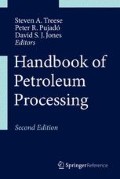Abstract
Hydrotreating or catalytic hydrogen treating removes objectionable materials from petroleum fractions by selectively reacting these materials with hydrogen in a reactor at relatively high temperatures and at moderate pressures. These objectionable materials include, but are not solely limited to, sulfur, nitrogen, olefins, and aromatics. The lighter distillates, such as naphtha, are generally treated for subsequent processing in catalytic reforming units, and the heavier distillates, ranging from jet fuels to heavy vacuum gas oils, are treated to meet strict product quality specifications or for use as feedstocks elsewhere in the refinery. Hydrotreating is also used for upgrading the quality of atmospheric and vacuum resids by reducing their sulfur and organometallic levels. Hydrotreaters are designed for and run at a variety of conditions depending on many factors such as feed type, desired cycle length, and expected quality of the products. Until about 1980, hydrotreating was a licensed technology being offered by a fairly large number of companies. From 1980 until the end of the last century, hydrotreating catalysts were becoming more commoditized as the formulations were less differentiated among the various suppliers. Many of the product quality specifications are driven by environmental regulations, and these regulations are becoming more stringent every year. With the advent of ultra-low-sulfur fuel regulations ushering in the first decade of the twenty-first century, however, it was required for hydrotreating research and development to deliver quantum improvements in catalyst performance and process technology. This was accomplished in the form of so-called Type II supported transition metal sulfide (TMS) catalysts, unsupported/bulk TMS catalysts, improved bed grading catalysts and stacking strategies, advanced catalyst loading techniques, improved trickle-flow reactor internals designs, and more effective catalyst activation methodologies.
Access this chapter
Tax calculation will be finalised at checkout
Purchases are for personal use only
References
P.E.M. Berthelot, Methode universelle pour réduire et saturer d’hydrogéne les composés organiques. Bull. Soc. Chim. 11(278), 278–286 (1869)
M. Breysse, C. Geantet, P. Afanasiev, J. Blanchard, M. Vrinat, Catal. Today 130, 3–13 (2008)
J. Čejka, Appl. Catal. Gen. 254, 327–338 (2003)
F. Chainet, Ph.D. Thesis, Spéciation du silicium dans les charges d’hydrotraitement, 2012
R.R. Chianelli, G. Berhault, B. Torres, Unsupported transition metal sulfide catalysts: 100 years of science and application. Catal. Today 147(3–4), 275 (2009)
A.I. Dugulan, High Pressure Sulfidation of Hydrotreating Catalysts – Genesis and Properties of the Active Phase, Delft University Press (IOS Press, 2008)
S. Eijsbouts, S. Mayo, K. Fujita, Unsupported transition metal sulfide catalysts: from fundamentals to industrial application. Appl. Catal. Gen. 322, 58 (2007). Active Phases for Hydrotreating Catalysis
N. Frizi, P. Blanchard, E. Payen, P. Baranek, C. Lancelot, M. Rebeilleau, C. Dupuy, J.P. Dath, Catal. Today 130, 32–40 (2008)
R. Hadden, T. Moss, Dealing with mercury in refinery processes, PTQ Q3 (2010)
E.J.M. Hensen, V.H.J. de Beer, J.A.R. van Veen, R.A. van Santen, Catal. Lett. 84(1), 59 (2002)
T. Ho, Inhibiting effects in hydrodesulfurization of 4,6-diethyldibenzothiophene. J. Catal. 219, 442–451 (2003)
T. Ho, Deep HDS of diesel fuel: chemistry and catalysis. Catal. Today 98, 3–18 (2004)
V.N. Ipatieff, Russkoe Fiziko-Kimischeskoe Obshchestvo, 33, 143–154, 496–506, 532–545, 632–643 (1900–1902)
L. Jones, P. Kokayeff, Distillate hydrotreating to ULSD – the impact of aromatics, in Paper 90a, AIChE 2004 Spring National Meeting, 27 Apr 2004
L. Jones, P. Kokayeff, Equilibrium limitations in distillate hydrotreating, in Paper 61d, AIChE 2005 Spring National Meeting, 10 Apr 2005
L. Leonard, P. Kokayeff, Recombination – a complicating issue in FCC naphtha desulfurization, in Paper 177c, AIChE 2006 Spring National Meeting, 26 Apr 2006
M. Pier, Z. Elektrochem. 53, 297 (1949)
P. Sabatier, J.B. Senderens, Action du nickel sur l’éthyléne. Compt. Rend 124, 1358 (1897)
A.N. Stranges, Friedrich Bergius and the rise of the German synthetic fuel industry. Isis (Hist. Sci. Soc.) 75(4), 643–667 (1984)
H. Topsøe, B.S. Clausen, Importance of Co-Mo-S type structures in hydrodesulfurization. Catal. Rev. Sci. Eng. 26(3), 395 (1984)
H. Topsøe, B. Clausen, F.E. Massoth, Catalysis: science and technology, vol. 11 (Springer, Berlin, 1996)
O. Weisser, S. Landa, Sulfide catalysts: their properties and applications (Pergamon, Oxford, 1973)
W.R.K. Wu, H.H. Storch, Hydrogenation of coal and tar. Bur. Min. Bull. 633, (1968)
TransportPolicy.Net, Nationwide Diesel and Gasoline Sulfur Limits (International Council on Clean Transportation, 2014), http://www.TransportPolicy.Net
Author information
Authors and Affiliations
Corresponding author
Editor information
Editors and Affiliations
Rights and permissions
Copyright information
© 2015 Springer International Publishing Switzerland
About this entry
Cite this entry
Kokayeff, P., Zink, S., Roxas, P. (2015). Hydrotreating in Petroleum Processing. In: Treese, S., Pujadó, P., Jones, D. (eds) Handbook of Petroleum Processing. Springer, Cham. https://doi.org/10.1007/978-3-319-14529-7_4
Download citation
DOI: https://doi.org/10.1007/978-3-319-14529-7_4
Published:
Publisher Name: Springer, Cham
Print ISBN: 978-3-319-14528-0
Online ISBN: 978-3-319-14529-7
eBook Packages: EnergyReference Module Computer Science and Engineering

